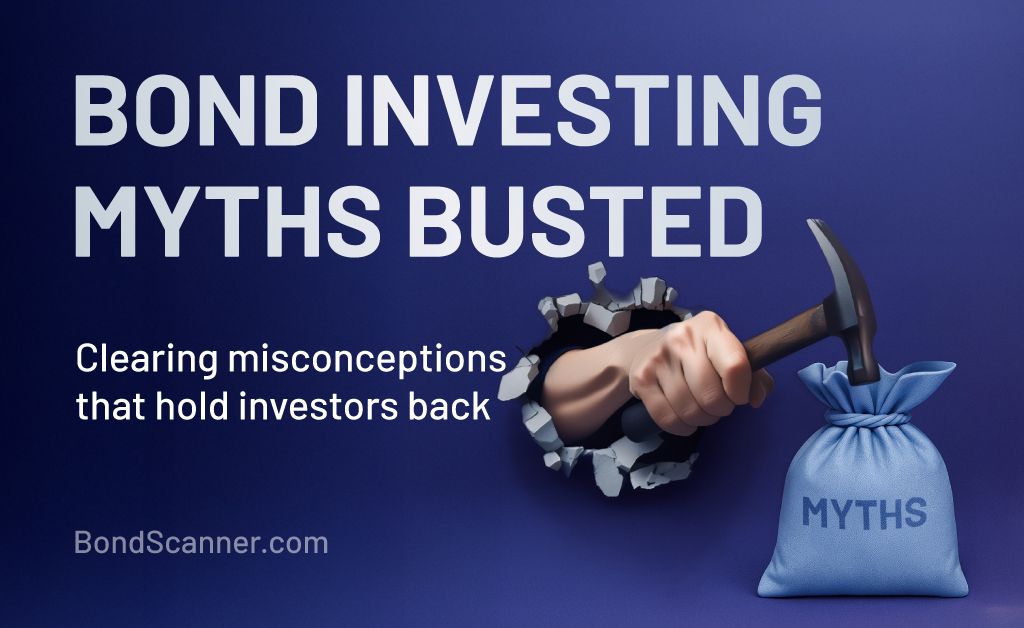Bond Investing Myths Busted
05 November 2025

Introduction
Bonds have long been seen as the “safer” cousin of equities — providing stability and predictable income. Yet, despite their importance in financial markets, several myths and misconceptions continue to cloud investor understanding.
At BondScanner, we believe in empowering investors with knowledge, transparency, and clarity. This article aims to debunk some of the most common myths surrounding bond investments so you can make informed financial decisions.
Myth 1: Bonds Are Only for Retirees
Many investors think bonds are suitable only for older individuals seeking stable income post-retirement. In reality, bonds can play a vital role in every investor’s portfolio, regardless of age.
Young investors can benefit from bonds to:
Stabilize returns during volatile equity markets.
Diversify portfolios by balancing high-risk assets with predictable income.
Build a reliable foundation for long-term goals like home ownership or education.
Bonds are not just for retirees — they’re for anyone seeking balanced growth and steady income.
Myth 2: Bonds Don’t Offer Good Returns
While bonds typically provide lower returns compared to equities, that doesn’t make them inferior. Bonds offer consistent, predictable cash flows through coupon payments and principal repayment at maturity.
Moreover, corporate bonds and non-convertible debentures (NCDs) often provide higher yields than traditional fixed deposits, depending on the issuer’s credit rating and market conditions.
The key is understanding your risk-return trade-off. Bonds can deliver solid risk-adjusted returns, especially in uncertain or declining equity markets.
Myth 3: Bonds Are Risk-Free Investments
This is one of the most common misconceptions. No investment is entirely risk-free, and bonds are no exception.
Here are the main types of risks bond investors should be aware of:
Credit Risk: The issuer might default on interest or principal payments.
Interest Rate Risk: When market interest rates rise, existing bond prices tend to fall.
Liquidity Risk: Some bonds may not trade frequently, making them harder to sell before maturity.
Government securities (G-Secs) generally carry lower risk, while corporate bonds vary based on the issuer’s creditworthiness. Always review credit ratings and bond documentation carefully before investing.
Myth 4: Bonds Are Complicated to Understand
Bonds may seem technical, but their core concept is simple. When you buy a bond, you are lending money to a government or corporation for a fixed period. In return, the issuer promises to pay regular interest (coupon) and return your principal amount at maturity.
Key terms every bond investor should know:
Coupon Rate: The fixed interest rate paid periodically.
Yield: The effective rate of return based on market price.
Tenure/Maturity: The period until the bond principal is repaid.
Credit Rating: Indicates the issuer’s financial reliability (e.g., AAA, AA, A, BBB).
Bond investing becomes straightforward when you understand these fundamentals.
Myth 5: Bonds Are Illiquid and Hard to Sell
Thanks to digital platforms, investors can now access, compare, and invest in bonds seamlessly. Bonds listed on exchanges can be traded before maturity, although their liquidity depends on demand and market activity.
Institutional-grade infrastructure, regulatory oversight by SEBI, and transparent pricing have significantly improved liquidity in the Indian bond market.
So while some bonds may have limited buyers, most rated and exchange-listed bonds can be traded efficiently through regulated platforms.
Myth 6: You Need Huge Capital to Invest in Bonds
This myth dates back to when bonds were primarily available in large denominations. Today, retail investors can invest in bonds starting as low as ₹10,000.
Platforms like BondScanner make it easier to:
Browse bonds from multiple issuers.
View ratings, yields, and maturity details transparently.
Invest in bite-sized quantities to build a diversified bond portfolio.
You don’t need large capital to start — just awareness and a systematic approach.
Myth 7: Bonds Don’t Belong in a Growth Portfolio
Many investors believe bonds only preserve capital rather than contribute to growth. However, bonds play a crucial role in optimizing long-term returns.
By lowering portfolio volatility and ensuring steady income, bonds allow investors to stay invested during market downturns — a key factor in long-term wealth creation.
A well-diversified portfolio usually includes a mix of equities for growth and bonds for stability and income.
Myth 8: Bond Ratings Guarantee Safety
Credit ratings like AAA or AA provide valuable insights into an issuer’s creditworthiness, but they do not eliminate risk entirely. Ratings can change based on the issuer’s financial performance or market conditions.
Therefore, investors should not rely solely on ratings. Instead, they should:
Review the issuer’s financial health.
Check bond covenants and repayment history.
Stay updated with any rating revisions or regulatory announcements.
Ratings help in assessing risk but should always be part of a broader due diligence process.
Why Bonds Still Matter in Modern Portfolios
Despite these myths, bonds remain one of the most reliable and essential instruments for wealth preservation and income generation.
Here’s why investors continue to include bonds in their portfolios:
Stability: Less volatile than equities.
Income: Regular interest payments.
Diversification: Reduce overall portfolio risk.
Transparency: Regulated by SEBI with clear disclosures.
With growing accessibility through online bond platforms, investors can now explore diverse fixed-income opportunities across tenures, ratings, and issuers.
Frequently Asked Questions (FAQs)
1. Can I lose money by investing in bonds?
Yes, if the issuer defaults or you sell the bond before maturity at a lower market price. However, choosing rated and secured bonds can reduce such risks.
2. Are bonds better than fixed deposits?
Both have different purposes. Bonds can offer higher yields and tradability, while FDs offer fixed returns with bank-backed security.
3. What’s the difference between a bond’s coupon rate and yield?
The coupon rate is the fixed interest paid by the issuer, while yield is the actual return based on the bond’s market price.
4. How do I start investing in bonds?
You can invest through SEBI-registered Online Bond Platform Providers like BondScanner, which provide transparent listings, ratings, and transaction processes.
5. Are all bonds taxable?
Yes, interest income from most bonds is taxable as per your income slab. However, certain government bonds may offer tax benefits.
Conclusion
Bond investing is no longer limited to financial experts or large institutions. With better access, transparency, and technology-driven platforms, retail investors can explore bonds as an effective way to build stable and diversified portfolios.
By clearing these common myths, investors can approach bond investing with greater confidence and understanding — making it a valuable part of their long-term financial journey.
Disclaimer
This blog is intended solely for educational and informational purposes. The bonds and securities mentioned herein are illustrative examples and should not be construed as investment advice or personal recommendations. BondScanner, as a SEBI-registered Online Bond Platform Provider (OBPP), does not provide personalized investment advice through this content.
Readers are advised to independently evaluate investment options and seek professional guidance before making financial decisions. Investments in bonds and other securities are subject to market risks, including the possible loss of principal. Please read all offer documents and risk disclosures carefully before investing.
Recent Blogs

Covered Bonds & Senior Secured Bonds Explained
An educational guide explaining covered bonds, senior secured bonds, what secured bonds mean, and how these instruments function in India’s bond market.
19 Dec 2025

Guide to Capital Gain Bonds (54EC) & Alternatives
An educational guide explaining capital gain bonds under Section 54EC, issuer options like PFC and SBI, eligibility rules, and alternatives for reinvesting sale proceeds.
19 Dec 2025

Bond ETFs in India: How They Work & When to Use Them
An educational guide explaining bond ETFs in India, their structure, returns, risks, and how products like Bharat Bond ETF and corporate bond ETFs function.
19 Dec 2025